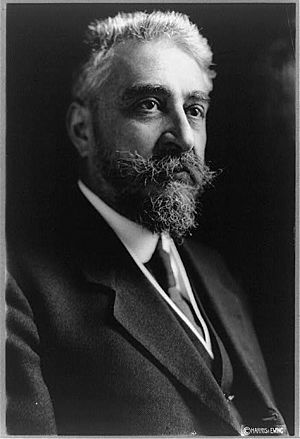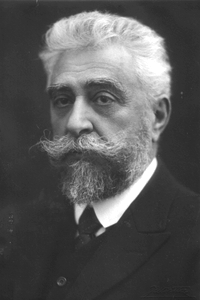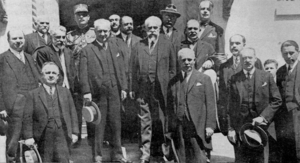Ion I. C. Brătianu facts for kids
Quick facts for kids
Ion I. C. Brătianu
|
|
|---|---|
 |
|
| Prime Minister of Romania | |
| In office 9 January 1909 – 28 December 1910 4 January 1914 – 28 January 1918 29 November 1918 – 26 September 1919 17 January 1922 – 29 March 1926 21 June 1927 – 24 November 1927 |
|
| Monarch | Carol I Ferdinand Michael |
| Preceded by | Dimitrie Alexandru Sturdza Titu Maiorescu Constantin Coandă Take Ionescu Barbu Ştirbey |
| Succeeded by | Petre P. Carp Alexandru Averescu Artur Văitoianu Alexandru Averescu Vintilă Brătianu |
| Personal details | |
| Born |
Ionel I. C. Brătianu
20 August 1864 Ștefănești, United Principalities of Moldavia and Wallachia |
| Died | 24 November 1927 (aged 63) Bucharest, Romania |
| Political party | National Liberal Party |
| Spouses | Maria Moruzi Eliza Știrbey |
| Profession | Engineer |
Ion Ionel Constantin Brătianu (born August 20, 1864 – died November 24, 1927) was an important Romanian politician. He led the National Liberal Party (PNL) and served as Prime Minister of Romania five times. He was also the Foreign Minister on several occasions.
Ionel Brătianu played a key role in Romania's history, especially after World War I. During his time as Prime Minister, Romania grew much larger. This period saw the joining of the Old Romanian Kingdom with Transylvania, Bukovina, and Bessarabia. This led to the creation of what is known as Greater Romania. In 1923, he became an honorary member of the Romanian Academy.
Contents
Ionel Brătianu's Early Life
Ionel Brătianu was born at Florica, his family's estate in Ștefănești, Argeș County. He finished high school at the Saint Sava National College in Bucharest in 1882.
After school, he joined the Romanian Army as an artillery soldier for six months. He then became a Second Lieutenant. During his military service, Brătianu studied engineering. In 1883, he went to Paris to continue his studies. He attended the Collège Sainte-Barbe and took classes at the École Nationale des Ponts et Chaussées from 1884 to 1889. He earned an engineer's diploma.
In 1889, he returned to Romania and was promoted to Lieutenant in the Army. Later that year, he started working for the Romanian Railways as an engineer. He worked under the famous engineer Anghel Saligny.
Ionel Brătianu's Start in Politics
Brătianu joined the PNL in 1895. In the same year, he was elected to the Parliament of Romania. He quickly became an important figure.
He served as the Minister of Public Works from 1897 to 1899 and again from 1901 to 1902. He also became the Minister of the Interior from 1907 to 1908. This happened after the 1907 Peasants' Revolt, which was a major uprising by farmers.
In 1909, he was chosen to lead the National Liberal Party. He held this position until he died. He became Prime Minister for the first time in January 1909, serving until December 1910.
Brătianu supported changes to land ownership, known as land reform. This was a big issue in Romania at the time. He also pushed for a fairer voting system that would give more power to the peasant majority. These ideas were supported by King Carol I and even the Conservative Party.
Romania During World War I
When World War I started in 1914, there was a big debate in Romania. Some wanted to stay neutral, others wanted to join the Central Powers. Brătianu and his party wanted Romania to join the Entente Forces.
Brătianu was Prime Minister again from 1914 to 1918. At first, King Carol I stopped Romania from joining the war. After King Carol's death in September 1914, Ferdinand I became king. King Ferdinand was a strong ally of Brătianu.
The government started secret talks with the Entente. Romania agreed to join the war if it could gain lands from Austria-Hungary where many Romanians lived. In August 1916, Romania declared war on Austria-Hungary.
Romanian troops advanced into Transylvania, but the Central Powers fought back. They took over parts of Romania, including Bucharest. The government had to move to Iaşi. Even though Romania faced difficulties, the Romanian Army managed to stop further attacks in battles like Mărășești and Mărăști.
The war changed when Russia left the conflict after the October Revolution. This left Romania without strong allies. Romania signed an armistice and then the Treaty of Bucharest in May 1918.
However, Romania never officially approved this treaty. In October 1918, Romania re-entered the war on the Entente's side. The Compiègne armistice in November 1918 made the Bucharest Treaty invalid.
After the War: Greater Romania
After the war, Brătianu became Prime Minister again in December 1918. He led the Romanian group at the 1919 Paris Peace Conference. There, he strongly supported the union of Transylvania and Bukovina with Romania.
Even though Romania gained most of the territories it wanted, Brătianu resigned in 1919. He did not agree to a compromise on some disputed lands in Banat. However, Romania had already achieved other big successes. Russia's exit from the war led to the union with Bessarabia, forming the Moldavian Democratic Republic.
The PNL faced new challenges in Greater Romania. Brătianu worked with other political leaders to keep the country stable. He supported General Alexandru Averescu for a time to help with land reform.
Brătianu's Later Cabinets
Brătianu became Prime Minister for the fourth time in January 1922, serving until March 1926. During this term, his government adopted the Constitution of 1923. This new constitution confirmed that all men could vote and protected the rights of minority groups. It also started a national land reform program.
In 1926, the National Peasants' Party became very strong. King Ferdinand asked General Averescu to form a new government. Brătianu later supported a different government under Barbu Ştirbey.
On June 21, 1927, Brătianu returned as Prime Minister for his fifth and final term. He died in Bucharest later that year from health problems. His brother, Vintilă Brătianu, took over as Prime Minister.
See also
 In Spanish: Ion Brătianu para niños
In Spanish: Ion Brătianu para niños



